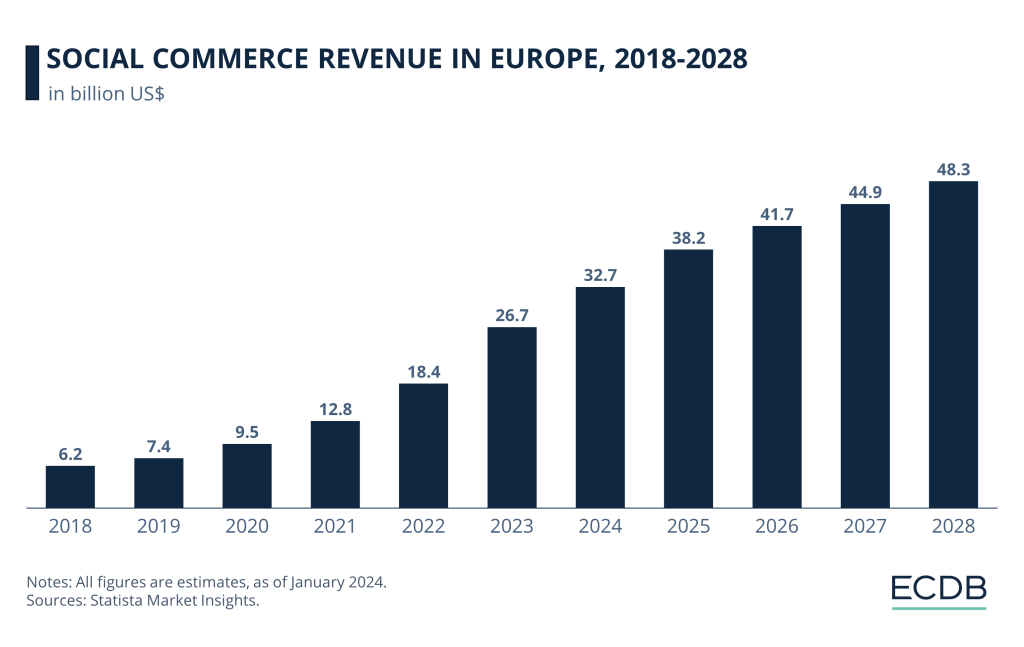Social commerce, the merging of social media and e-commerce, has evolved from being a mere online community-building tool into a powerful sales platform. What started as businesses marketing their products through social media posts has grown into a full-fledged sales channel, where consumers can discover, engage with, and purchase products without leaving their favorite apps. As social media continues to dominate the way people connect, socialize, and shop, brands are leveraging social commerce to turn casual engagement into revenue.
In this blog, we’ll explore how social commerce has developed, the driving forces behind its growth, and how brands can leverage it to convert likes into sales.
Table of Contents:
- What Is Social Commerce?
- Early Days of Social Commerce
- The Rise of Shoppable Posts
- How Social Commerce Transforms Customer Experience
- Key Features of Modern Social Commerce
- Major Social Media Platforms and Their Commerce Features
- Benefits of Social Commerce for Businesses
- Challenges of Social Commerce
- How to Turn Social Media Engagement into Sales
- The Future of Social Commerce

1. What Is Social Commerce?
Social commerce refers to the use of social media platforms to facilitate online shopping. Unlike traditional e-commerce, where users visit a dedicated website to purchase, social commerce allows users to browse, engage, and buy products directly from their favorite social networks. This trend has made social platforms an extension of the online shopping experience, blending social interaction with commercial opportunities.
Popular platforms like Instagram, Facebook, Pinterest, and TikTok have introduced features such as shoppable posts, in-app checkouts, and product catalogs, enabling brands to monetize their social media presence seamlessly.
2. Early Days of Social Commerce
The concept of social commerce emerged in the early 2010s when brands began using Facebook and Instagram to promote products, but at that time, these platforms were primarily used for building brand awareness, not sales. Businesses would post product photos and links to their websites, redirecting traffic to external e-commerce stores.
At this stage, social media engagement (likes, comments, shares) played a significant role in brand visibility and customer trust. However, converting that engagement into direct sales was still a challenge, as it involved multiple steps: discovery, redirection to a website, browsing, and checkout.
3. The Rise of Shoppable Posts
The evolution from simple social media marketing to fully integrated social commerce began with the introduction of shoppable posts. This feature allowed brands to tag products directly in their social media posts, enabling users to view product details and make purchases without leaving the platform.
- Instagram Shopping: Instagram led the way by introducing shoppable posts in 2018, allowing users to explore products tagged in photos and stories. This feature reduced the friction of navigating between apps and significantly boosted conversion rates.
- Facebook Marketplace: Facebook launched its Marketplace feature, providing a platform for businesses and individuals to sell products directly within the Facebook ecosystem.
- Pinterest Buyable Pins: Pinterest, a platform known for its focus on lifestyle inspiration, rolled out buyable pins, enabling users to purchase products without leaving the site.
This shift in user experience marked a pivotal moment in social commerce’s evolution, where social media went from being an advertising platform to a direct sales channel.
4. How Social Commerce Transforms Customer Experience
Social commerce is transforming the customer journey by making shopping more interactive, personalized, and convenient. Here are some ways it has enhanced customer experience:
A. Discovery and Shopping in One Place
Social commerce eliminates the need to switch between apps or websites. Users can discover a product on their feed, click on it, and purchase directly—all without leaving their favorite platform. This streamlined experience reduces the number of steps in the buyer journey, increasing the likelihood of conversion.
B. Social Proof and Influencer Impact
Social platforms naturally promote community interactions, and social proof plays a crucial role in purchasing decisions. Reviews, likes, shares, and comments provide customers with instant validation of a product’s quality or popularity. The rise of influencers also allows brands to leverage trusted voices to boost product credibility.
C. Real-Time Customer Interaction
Social commerce allows businesses to engage with customers in real-time. Whether answering questions via direct messages or responding to comments on a post, brands can address customer concerns quickly, improving customer satisfaction and confidence in purchasing.
5. Key Features of Modern Social Commerce
Several key features of social commerce are driving its adoption and success:
- Shoppable Tags: Users can click on tagged products in posts or stories and be directed to product details or the checkout process.
- In-App Checkout: Platforms like Instagram and Facebook have introduced in-app checkout features, allowing users to complete purchases without leaving the app.
- User-Generated Content (UGC): Brands are encouraging customers to share their experiences with products, providing authentic content that can influence others to buy.
- Livestream Shopping: This feature, popularized in Asia, allows brands to showcase products in real-time via livestreams. Viewers can purchase products directly from the livestream feed.
- Personalized Recommendations: AI algorithms track user behavior to suggest products that align with their preferences, increasing the chances of conversion.
6. Major Social Media Platforms and Their Commerce Features

Each major social media platform has integrated features that cater to social commerce:
A. Instagram
Instagram’s primary social commerce features include shoppable posts, stories, Instagram Shopping, and in-app checkout. The platform is visually driven, making it ideal for brands with aesthetic appeal.
B. Facebook
Facebook offers several commerce features such as Facebook Shops, Marketplace, and in-app payment options. It allows businesses to set up full e-commerce stores within Facebook and target specific audience segments using Facebook Ads.
C. TikTok
TikTok’s rise in social commerce is driven by viral videos and influencer collaborations. The platform has introduced TikTok Shopping, which integrates product links within short-form videos and allows in-app purchases.
D. Pinterest
Pinterest’s visual focus makes it a strong player in the social commerce space. Buyable pins and product recommendations allow users to discover and purchase items that align with their inspiration boards.
E. Snapchat
Snapchat has embraced augmented reality (AR) shopping, where users can try on products virtually before purchasing. This immersive experience adds an element of interactivity that is unique to the platform.
7. Benefits of Social Commerce for Businesses
Social commerce offers several advantages for businesses looking to increase sales and brand engagement:
A. Increased Conversions
The seamless shopping experience within social platforms reduces friction in the customer journey, resulting in higher conversion rates.
B. Higher Engagement
Shoppable posts and interactive content, like live shopping events, drive user engagement, encouraging likes, comments, and shares, which boost product visibility.
C. Access to Social Data
Businesses can leverage data from social platforms to understand customer behavior, optimize ad targeting, and improve product offerings based on audience preferences.
D. Enhanced Brand Loyalty
By engaging with customers directly through social media and offering personalized experiences, businesses can build stronger customer relationships and foster brand loyalty.
8. Challenges of Social Commerce
While social commerce has many benefits, it also presents several challenges for businesses:
A. Platform Dependence
Relying too heavily on one social platform can be risky, especially if the platform’s algorithms change or if there are technical issues. Diversification is key.
B. Data Privacy and Security
As with any form of e-commerce, data privacy is a concern. Brands must ensure that their social commerce activities comply with privacy regulations and safeguard customer information.
C. Maintaining Authenticity
Over-commercialization can lead to disengagement. Brands must strike a balance between promoting products and maintaining an authentic social media presence.
9. How to Turn Social Media Engagement into Sales
To successfully convert likes, shares, and comments into sales, businesses must follow a strategic approach:
A. Leverage Influencer Marketing
Partnering with influencers can amplify a brand’s reach and lend credibility to products. Influencers with loyal followers can directly impact buying decisions through product recommendations.
B. Create Engaging and Shoppable Content
Shoppable posts, stories, and reels that showcase product benefits or use cases in creative ways are more likely to capture attention and drive purchases.
C. Use Data-Driven Insights
Social platforms offer a wealth of data on customer behavior. Brands should analyze this data to fine-tune their marketing strategies, optimize ad targeting, and create personalized experiences.
D. Foster Community and Authentic Engagement
Focus on creating meaningful connections with your audience by encouraging user-generated content, responding to comments, and holding interactive events like Q&A sessions or livestreams.
10. The Future of Social Commerce
Social commerce is set to grow exponentially in the coming years as more platforms integrate shopping features and as consumers become more comfortable making purchases within social apps. Key trends include:
- AR and VR Integration: Augmented reality (AR) and virtual reality (VR) shopping experiences will likely become more widespread, allowing users to “try before they buy.”
- AI-Powered Personalization: AI will play a larger role in personalizing the social shopping experience, offering real-time recommendations based on individual preferences.
- Global Adoption: As social commerce becomes more prevalent, we can expect increased adoption in emerging markets, where mobile-first users will drive sales through social platforms.
Conclusion
The evolution of social commerce is transforming the way consumers discover and purchase products. By seamlessly integrating shopping with social media, brands can turn likes, shares, and comments into tangible sales. While social commerce offers numerous benefits, it also requires a strategic approach to succeed in the long run. By focusing on engagement, authenticity, and data-driven insights, businesses can unlock the full potential of social commerce and create a thriving sales channel.





Leave a Reply